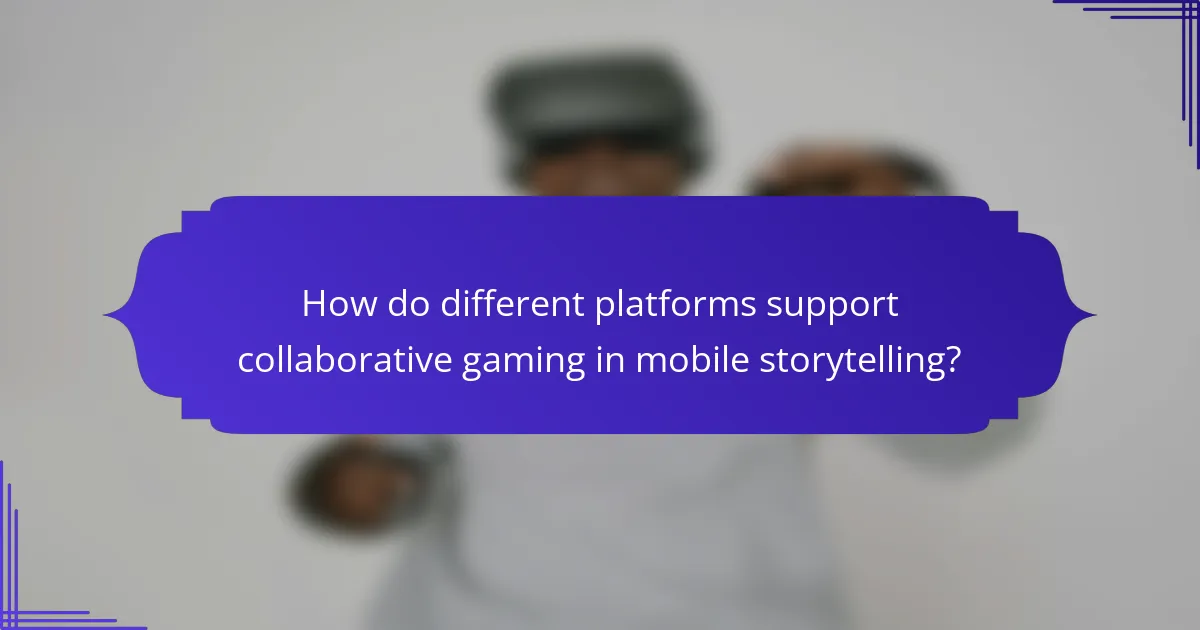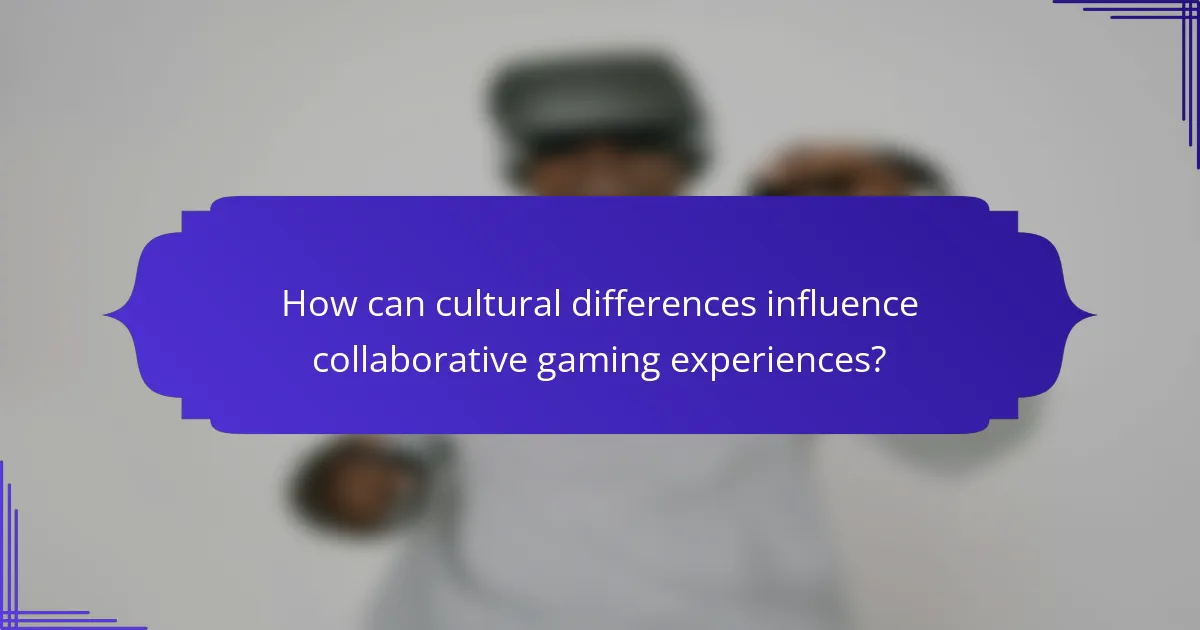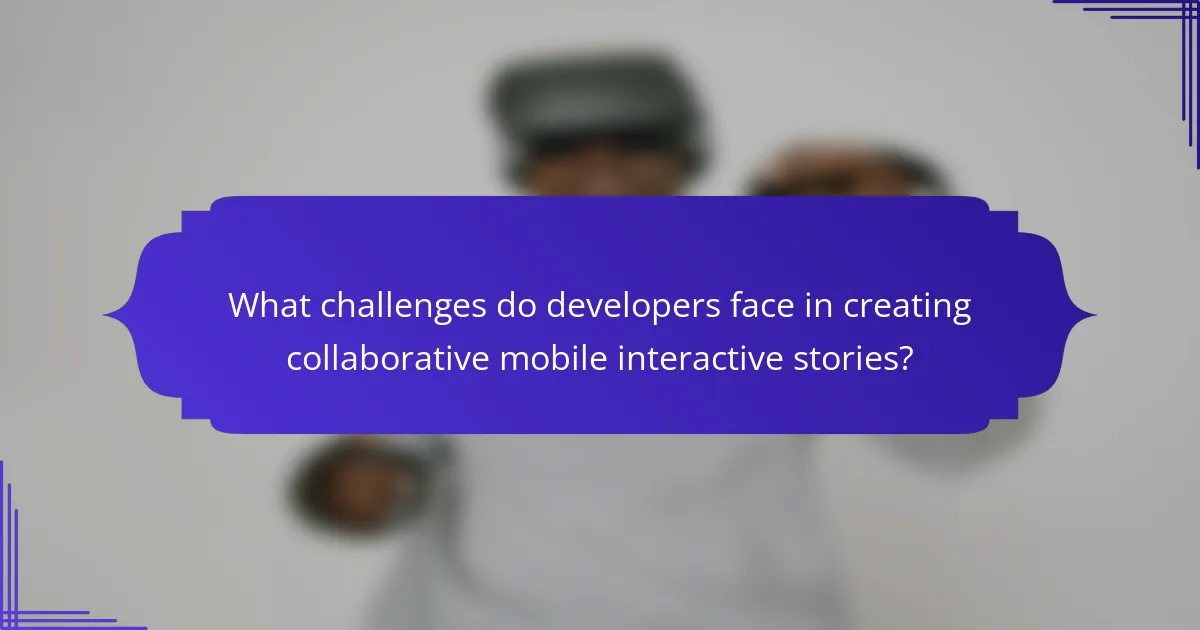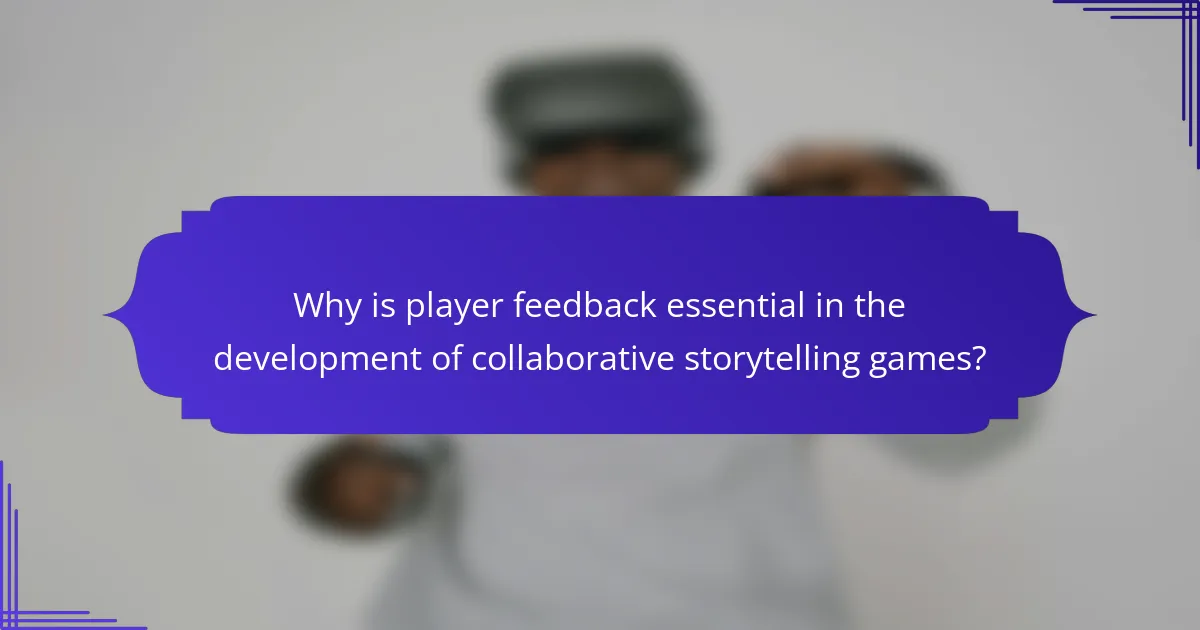Collaborative gaming in mobile interactive storytelling significantly enhances player engagement and creativity. It promotes teamwork through shared decision-making and real-time communication. Players enjoy diverse perspectives, leading to richer narratives and increased replayability. Additionally, cultural diversity fosters inclusivity and empathy, further enriching the gaming experience.

What are the key advantages of collaborative gaming in mobile interactive storytelling?
Collaborative gaming in mobile interactive storytelling enhances player engagement, creativity, and social interaction. It fosters teamwork, allowing players to share diverse perspectives and strategies. This approach cultivates a sense of community, enhancing the overall experience through shared narratives. Additionally, collaborative gaming can lead to increased replayability as players explore different outcomes together.
How does collaboration enhance player engagement and immersion?
Collaboration significantly enhances player engagement and immersion in mobile interactive storytelling. It fosters social connections, encourages teamwork, and deepens narrative experiences. Players become more invested in the story through shared decision-making, resulting in a richer emotional connection to the game. Collaborative gameplay often leads to unique outcomes, as players navigate challenges together, making each playthrough distinct and memorable. This unique attribute of collaborative gaming drives replayability, keeping players engaged over time.
What role does social interaction play in the gaming experience?
Social interaction significantly enhances the gaming experience by fostering collaboration and engagement. Collaborative gaming in mobile interactive storytelling allows players to share narratives, strategize, and solve challenges together. This interaction builds community, increases emotional investment, and enhances storytelling immersion. Players can experience unique attributes, such as real-time decision-making and collective problem-solving, which enrich the overall gameplay. As a result, social dynamics in gaming contribute to a more fulfilling and memorable experience.
Which cognitive benefits can arise from collaborative gameplay?
Collaborative gameplay in mobile interactive storytelling enhances cognitive benefits such as problem-solving skills, critical thinking, and creativity. Players engage in teamwork, which fosters communication and social interaction. This environment encourages strategic planning and adaptability, as players must respond to dynamic narratives. Additionally, shared decision-making improves memory retention and cognitive flexibility.

How do different platforms support collaborative gaming in mobile storytelling?
Collaborative gaming enhances mobile interactive storytelling by fostering teamwork, creativity, and engagement. Different platforms support this through features like real-time communication, shared decision-making, and customizable narratives. These elements allow players to co-create stories, making experiences more immersive and personalized. Cross-platform compatibility also enables diverse player participation, enriching the collaborative aspect.
Which mobile platforms are most popular for interactive storytelling?
Mobile platforms like iOS and Android dominate the landscape of interactive storytelling in collaborative gaming. Their extensive user bases and advanced capabilities foster engaging narratives and rich interactions.
iOS offers seamless integration with high-quality graphics, while Android provides a diverse range of devices catering to various preferences. Both platforms support multiplayer functionalities, enhancing collaborative experiences.
The popularity of mobile interactive storytelling is evident in the rise of apps like “Episode” and “Choices,” which emphasize user participation and decision-making. These platforms leverage social sharing features, allowing players to connect and collaborate on narratives.
As a result, mobile platforms continue to shape the future of interactive storytelling, creating immersive environments that captivate audiences worldwide.
How does user interface design impact collaborative experiences across platforms?
User interface design significantly enhances collaborative experiences across platforms by facilitating communication and interaction. Effective design promotes user engagement, ensuring seamless navigation and accessibility. Intuitive interfaces reduce cognitive load, allowing players to focus on storytelling. Collaborative features, like shared decision-making and real-time updates, enhance immersion and connection among users. A well-designed interface can adapt to various devices, ensuring consistent experiences across mobile platforms. This adaptability fosters inclusivity, allowing diverse user groups to participate in interactive storytelling.

What unique features distinguish collaborative mobile interactive storytelling games?
Collaborative mobile interactive storytelling games stand out due to their unique features that enhance player engagement. These games promote social interaction, allowing players to co-create narratives and influence story outcomes collectively.
They often incorporate real-time communication tools, enabling seamless collaboration. Players can share ideas, make decisions, and contribute to the storyline, fostering a sense of community.
Moreover, these games utilize adaptive storytelling mechanics, where the narrative evolves based on group choices. This dynamic approach ensures that each playthrough is distinct, enhancing replayability.
Lastly, collaborative elements often include role differentiation, where players assume unique roles that complement each other, leading to richer storytelling experiences.
How do narrative choices differ in collaborative formats compared to solo play?
Collaborative gaming enhances narrative choices by allowing players to influence the story collectively. In collaborative formats, players share decision-making, leading to diverse plot developments and character arcs. This contrasts with solo play, where the narrative is typically linear and shaped solely by one player’s choices. Collaborative storytelling fosters creativity and social interaction, enriching the overall experience. Players can explore multiple perspectives and outcomes, making the narrative more dynamic and engaging.
Which game mechanics are specifically designed for collaboration?
Collaborative gaming incorporates mechanics like teamwork, resource sharing, and joint decision-making. These mechanics enhance player engagement and foster social interaction. For example, cooperative puzzles require players to communicate and strategize together. Additionally, shared objectives motivate players to collaborate effectively, resulting in a more immersive storytelling experience.

How can cultural differences influence collaborative gaming experiences?
Cultural differences can significantly enhance collaborative gaming experiences by fostering diverse perspectives and creativity. Players from various backgrounds contribute unique storytelling elements, enriching the narrative depth. This diversity encourages adaptability and problem-solving, as teams learn to navigate different communication styles and strategies. Additionally, cultural nuances can lead to innovative gameplay mechanics, appealing to a broader audience. Engaging with diverse cultures in mobile interactive storytelling promotes inclusivity and empathy among players, ultimately enhancing the overall gaming experience.
What regional preferences exist for storytelling styles in mobile games?
Regional preferences for storytelling styles in mobile games vary significantly. Collaborative gaming enhances engagement through shared narratives, appealing to cultures valuing community. For instance, Asian markets often favor intricate plots and character development, while Western audiences may prioritize action and pacing. These preferences influence game design, ensuring resonance with local players.
How do local gaming communities shape collaborative gameplay dynamics?
Local gaming communities significantly enhance collaborative gameplay dynamics by fostering teamwork, communication, and shared experiences. These communities create environments where players can strategize together, share resources, and develop narratives collectively. As a result, players often experience deeper engagement and satisfaction in mobile interactive storytelling.
Collaboration within these communities leads to unique gameplay dynamics, such as co-creation of storylines and character development. Players contribute diverse perspectives, enriching the narrative and making it more immersive. This collaborative approach not only strengthens social bonds but also encourages creativity and innovation in gameplay.
Furthermore, local gaming communities often host events and workshops that provide opportunities for players to collaborate in real-time. These interactions can lead to rare gameplay experiences that are not easily replicated in solo play. By participating in these communities, players can enhance their skills and learn new strategies, ultimately improving their overall gaming experience.
In summary, local gaming communities play a crucial role in shaping collaborative gameplay dynamics by promoting teamwork, enriching narratives, and providing unique experiences that enhance mobile interactive storytelling.

What challenges do developers face in creating collaborative mobile interactive stories?
Developers face several challenges in creating collaborative mobile interactive stories. Technical limitations, such as device compatibility and network connectivity, hinder seamless user experiences. Balancing narrative complexity with user input can complicate story development. Additionally, ensuring effective communication among players presents obstacles. User engagement varies, impacting collaboration quality. Finally, maintaining a cohesive storyline while accommodating diverse player choices poses a significant challenge.
How can technical limitations affect collaborative gameplay?
Technical limitations can hinder collaborative gameplay by creating barriers to communication, synchronization, and engagement among players. These limitations may include poor internet connectivity, device compatibility issues, and software bugs. For example, lag can disrupt real-time interactions, leading to frustration and reduced enjoyment. Additionally, limited device capabilities may restrict access to certain features, impacting the overall experience. Addressing these technical challenges is essential for maximizing the benefits of collaborative gaming in mobile interactive storytelling.
What are common pitfalls in balancing collaboration and narrative depth?
Balancing collaboration and narrative depth can lead to several pitfalls. One common issue is prioritizing player interaction over storytelling, resulting in a lack of cohesive narrative. Another pitfall is the difficulty in managing diverse player inputs, which can dilute the story’s focus and lead to inconsistencies. Additionally, overemphasis on collaborative elements may overshadow character development, leaving players disconnected from the narrative. Lastly, technical constraints can limit the depth of storytelling, affecting player engagement and experience.

Why is player feedback essential in the development of collaborative storytelling games?
Player feedback is crucial in collaborative storytelling games to enhance engagement and creativity. It allows developers to understand player preferences, improving narrative depth and interactivity. Feedback fosters a community-driven approach, enabling players to shape story arcs, character development, and gameplay mechanics. This iterative process leads to a more immersive experience, as players feel their input directly influences the outcome. Ultimately, integrating player feedback results in richer storytelling, increased player satisfaction, and a stronger connection to the game world.
How can developers effectively gather and implement player feedback?
Developers can effectively gather and implement player feedback by fostering open communication channels and actively engaging with the community. This collaboration enhances mobile interactive storytelling by integrating diverse player perspectives, leading to enriched narratives and gameplay experiences.
Utilizing surveys and in-game feedback tools allows developers to collect actionable insights. Regular updates based on this feedback demonstrate responsiveness, fostering player loyalty. Additionally, community forums and social media platforms serve as valuable spaces for dialogue, enabling developers to understand player preferences and pain points.
Implementing player feedback can result in unique attributes, such as tailored storylines or character development that resonate more deeply with the audience. This approach not only enhances player satisfaction but also drives long-term engagement and retention in collaborative gaming environments.
What impact does community-driven content have on game longevity?
Community-driven content significantly enhances game longevity by fostering player engagement and collaboration. This collaborative approach creates a dynamic ecosystem where players contribute to the game narrative and mechanics. As a result, games evolve through user-generated content, keeping the experience fresh and relevant.
Additionally, community contributions often lead to a deeper emotional connection among players, which can boost retention rates. Games that incorporate player feedback and ideas tend to see increased satisfaction, as players feel valued and heard. This ongoing interaction can also attract new players, sustaining the game’s popularity over time.
Moreover, unique attributes such as player-created quests or storylines can differentiate a game in a crowded market, making it more appealing. The rarity of quality community content can set a game apart, creating a dedicated fanbase that actively participates in its growth.
In summary, community-driven content not only enriches the gaming experience but also plays a crucial role in maintaining game longevity through continuous player involvement and innovation.

What are the best practices for optimizing collaborative gaming experiences?
Collaborative gaming enhances mobile interactive storytelling by fostering teamwork, creativity, and engagement. Best practices include designing inclusive narratives, ensuring seamless communication, and integrating diverse gameplay mechanics.
Inclusive narratives allow players to contribute uniquely, enhancing the story’s depth. Seamless communication tools, such as in-game chat or voice options, facilitate coordination and strategy. Diverse gameplay mechanics, including puzzles and role-playing elements, cater to different player preferences, promoting collaboration.
Balancing character strengths and weaknesses encourages teamwork, while regular updates maintain player interest. Providing clear objectives and rewards boosts motivation and satisfaction. These practices create immersive experiences that resonate with players, ultimately leading to successful collaborative gaming outcomes.
How can developers create inclusive environments for diverse player groups?
Developers can create inclusive environments for diverse player groups by prioritizing accessibility and fostering community engagement. Collaborative gaming in mobile interactive storytelling enhances social interaction and empathy among players. By integrating features like customizable avatars and adaptive difficulty levels, developers can cater to varied preferences and abilities. This approach not only increases player satisfaction but also promotes a sense of belonging, making gaming a more welcoming space for everyone.
What strategies enhance communication and teamwork among players?
Collaborative gaming enhances communication and teamwork among players by fostering shared goals and encouraging interaction. Players develop problem-solving skills and learn to coordinate strategies effectively.
Building trust is essential; players engage in dialogue, share feedback, and support each other’s decisions. This creates a sense of community, enhancing the overall gaming experience.
Moreover, mobile interactive storytelling allows for diverse roles, enabling players to contribute uniquely, which strengthens collaboration. By leveraging each player’s strengths, teams can achieve objectives more efficiently.
In conclusion, collaborative gaming promotes teamwork through shared experiences, communication, and role diversity, ultimately leading to more immersive and successful gaming outcomes.
How can game design encourage positive player interactions?
Collaborative gaming in mobile interactive storytelling fosters positive player interactions by encouraging teamwork and communication. Players engage in shared narratives, enhancing social bonds and empathy.
These games often feature cooperative challenges that require players to strategize together, promoting a sense of community. For instance, players may need to solve puzzles collectively, leading to increased collaboration and trust.
Additionally, collaborative gaming can reduce competition-related stress, allowing players to focus on enjoyment and creativity. This supportive environment cultivates a culture of respect and inclusivity among participants.
Ultimately, the benefits of collaborative gaming extend beyond gameplay, fostering lasting friendships and positive social experiences.
